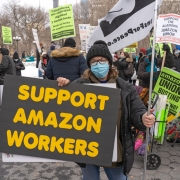New York State Workers’ Compensation Law: Documented or Undocumented in the USA, You Have Rights!
By Brian Figeroux, Esq.
New York State Workers’ Compensation Law is a crucial safety net for employees who suffer work-related injuries or illnesses. Designed to provide financial and medical benefits, this law ensures that workers receive necessary support without the burden of proving employer negligence. This article explores employees’ benefits under workers’ compensation, the process for filing a claim, avenues for assistance, tips for injured workers, and key information about COVID-19 claims. By understanding these aspects, workers can better protect their rights and access the benefits they are entitled to.
Employees’ Benefits Under Workers’ Compensation
Workers’ compensation in New York State offers several benefits, which fall into the following categories:
- Medical Benefits: Workers are entitled to full coverage for medical care related to their injury or illness. This includes doctor visits, surgeries, physical therapy, prescriptions, and necessary medical equipment. Providers must be authorized by the Workers’ Compensation Board (WCB).
- Wage Replacement: Injured employees unable to work are eligible for temporary disability benefits. Generally, this compensation equals two-thirds of the worker’s average weekly wage, multiplied by the percentage of their disability. These payments are subject to a weekly maximum set by the WCB.
- Permanent Disability Benefits: If an injury results in a permanent impairment, workers may qualify for benefits based on the severity of their disability. These are categorized as:
- Schedule Loss of Use (SLU): For permanent loss of function in a body part like an arm, leg, or eye.
- Non-Schedule Awards: For injuries affecting parts not listed in SLU, such as the back or brain.
- Death Benefits: If a worker’s injury leads to death, dependents may receive weekly cash benefits and funeral expenses. The benefit amount depends on the deceased worker’s earnings and the number of dependents.
- Vocational Rehabilitation: Workers unable to return to their prior jobs may access retraining services to prepare for alternative employment.
How to File a Claim
Filing a workers’ compensation claim in New York involves specific steps to ensure timely benefits:
- Immediate Notification to the Employer: Workers must inform their employer about the injury or illness within 30 days. Written notice is recommended to establish a clear record.
- Seek Medical Attention: Treatment must be provided by a doctor authorized by the WCB, except in emergencies.
- File Form C-3 with the WCB: Workers should complete Form C-3, “Employee Claim,” and submit it to the WCB as soon as possible, ideally within two years of the incident. This form outlines details about the injury and how it occurred.
- Employers File Form C-2F: Employers must report the injury to their insurance carrier within 10 days using Form C-2F.
- Cooperate with the Insurance Carrier’s Investigation: Insurers may require an Independent Medical Examination (IME) to assess the claim. Workers should comply to avoid delays or denial of benefits.
- Attend Hearings if Necessary: If the claim is disputed, the case may go before a WCB judge. Workers should provide all required documentation and may need legal representation.
How to Get Help With Your Claim if Needed
Navigating the workers’ compensation system can be challenging. Resources and support are available to ensure workers receive proper benefits:
- Workers’ Compensation Board: The WCB provides information, assistance, and dispute resolution services. Workers can contact the Board directly for help understanding their rights or resolving issues with their claim.
- Advocates and Legal Representation: Hiring an experienced workers’ compensation attorney can significantly improve outcomes. Attorneys help with filing claims, appealing denied claims, and ensuring maximum benefits. Law firms like Figeroux & Associates offer dedicated support to injured workers.
- Ombudsman for Injured Workers: This free resource helps workers understand the claims process, resolve disputes, and address delays without needing legal action.
- Union Assistance: If the worker is part of a union, union representatives can provide guidance and advocate on their behalf.
Tips and Best Practices for Injured Workers
Injured workers can take proactive steps to strengthen their claim and protect their rights:
- Report Injuries Promptly: Notify your employer immediately, even for minor injuries, as delays may raise doubts about the claim’s validity.
- Keep Detailed Records: Maintain documentation of medical visits, expenses, missed workdays, and correspondence with your employer or insurer.
- Follow Medical Advice: Adhere strictly to treatment plans and attend all scheduled appointments to demonstrate the seriousness of your injury.
- Be Honest and Consistent: Provide accurate and consistent information about the injury and its impact on your ability to work.
- Seek Legal Assistance Early: Consulting a lawyer early in the process ensures proper handling of the claim and prepares you for potential disputes.
Information to Be Aware of Regarding COVID-19 Claims
The COVID-19 pandemic introduced unique challenges to workers’ compensation. Workers who contract the virus at work may be eligible for benefits under specific conditions:
- Eligibility: Workers in high-risk roles, such as healthcare and essential services, may have stronger cases if exposed to COVID-19 while performing job duties.
- Proving Work-Related Exposure: Claimants must demonstrate that their exposure occurred during employment, often requiring evidence such as workplace conditions or outbreak documentation.
- Long COVID Claims: Workers experiencing prolonged COVID-19 symptoms may qualify for extended benefits if the condition impairs their ability to work.
- Filing Deadlines: The standard two-year deadline for claims applies to COVID-19 cases, starting from the date of diagnosis or the worker’s awareness of the work-related nature of the illness.
- Legislative Updates: Workers should stay informed about changes in state policies and regulations regarding COVID-19 claims, as these may evolve.
Conclusion
New York State Workers’ Compensation Law is a vital safeguard for employees facing workplace injuries or illnesses. Understanding available benefits, the claim process, and resources for assistance is essential for navigating this system effectively. For workers affected by COVID-19, staying informed about unique claim requirements ensures timely and appropriate benefits. Legal professionals like the Law Firm of Figeroux & Associates play a pivotal role in advocating for workers’ rights, ensuring that they receive the support they deserve.









Leave a Reply
Want to join the discussion?Feel free to contribute!